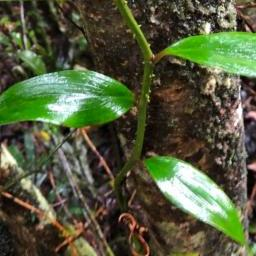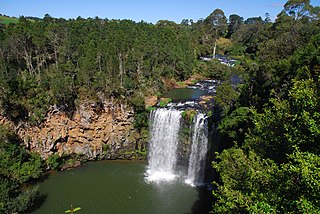
Lord Howe Island is an irregularly crescent-shaped volcanic remnant in the Tasman Sea between Australia and New Zealand, part of the Australian state of New South Wales. It lies 600 km (320 nmi) directly east of mainland Port Macquarie, 780 km (420 nmi) northeast of Sydney, and about 900 km (490 nmi) southwest of Norfolk Island. It is about 10 km (6.2 mi) long and between 0.3 and 2.0 km wide with an area of 14.55 km2, though just 3.98 km2 of that comprise the low-lying developed part of the island.

The Gondwana Rainforests of Australia, formerly known as the Central Eastern Rainforest Reserves, are the most extensive area of subtropical rainforest in the world. Collectively, the rainforests are a World Heritage Site with fifty separate reserves totalling 366,500 hectares from Newcastle to Brisbane.

Bomen is a northern suburb of Wagga Wagga in southern New South Wales, Australia. The suburb is dominated by industrial enterprises including Cargill Beef, Watties, the Wagga Wagga Livestock Marketing Centre (saleyards). The suburb is also home to Wagga Wagga's secondary railway station on the Main Southern line, when the line waited for the construction of a bridge over the Murrumbidgee River. New streets in Bomen are to be named after sheep and cattle breeds.

Sydney Water, formally, Sydney Water Corporation, is a New South Wales Government–owned statutory corporation that provides potable drinking water, wastewater and some stormwater services to Greater Metropolitan Sydney, the Illawarra and the Blue Mountains regions, in the Australian state of New South Wales.

Professor David John Mabberley, is a British-born botanist, educator and writer. Among his varied scientific interests is the taxonomy of tropical plants, especially trees of the families Labiatae, Meliaceae and Rutaceae. He is perhaps best known for his plant dictionary The plant-book. A portable dictionary of the vascular plants. The third edition was published in 2008 as Mabberley's Plant-book, for which he was awarded the Engler Medal in Silver in 2009. As of June 2017 Mabberley's Plant-book is in its fourth edition.

Toona ciliata is a forest tree in the mahogany family which grows throughout southern Asia from Afghanistan to Papua New Guinea and Australia.

City of Wagga Wagga is a local government area in the Riverina region of southern New South Wales, Australia.

Gilgandra Shire is a local government area in the Orana region of New South Wales, Australia. The Shire is located adjacent to the junction of the Newell, Oxley and Castlereagh highways and can be reached in about six hours by car from Sydney CBD. The Shire lies on the Castlereagh River and includes part of the Warrumbungles National Park. The shire was constituted in 1906.

Tallawarra Power Station is a 435-megawatt (583,000 hp) combined cycle natural gas power station in the city of Wollongong, New South Wales, Australia. Owned and operated by EnergyAustralia, the station is the first of its type in New South Wales and produces electricity for the state during periods of high demand. It is located on the western shore of Lake Illawarra in the suburb of Yallah.

Aphanopetalum is a genus of twining shrubs or vines in the family Aphanopetalaceae which are endemic to Australia.

Petermannia is the sole genus of plants in the family Petermanniaceae. Petermannia cirrosa, the only species in the genus, is endemic to the states of New South Wales and Queensland in Australia. it is a prickly, wiry stemmed vine which grows to 6 metres in height and has lancelote, ovate or elliptic leaves with an acute apex. The flowers, which appear during summer, have reflexed reddish green or white tepals. These are followed by rounded red berries.

Cassytha melantha is a parasitic vine. Common names include coarse dodder-laurel and large dodder-laurel. The fruits are about 10–15 millimetres (0.39–0.59 in) in diameter and are green, drying to black. These are edible and are harvested in the wild.

Podolobium, commonly known as shaggy peas, is a genus of six species of flowering plants in the family Fabaceae that are endemic to eastern Australia. The genus was formally described by botanist Robert Brown in Hortus Kewensis in 1811.

Podolobium alpestre, commonly known as alpine shaggy-pea, is a flowering plant in the family Fabaceae and is endemic to south-eastern Australia. It has oblong to egg-shaped leaves and yellow to orange pea-like flowers with red markings.
Colongra Gas Generation Plant is a 667 MW gas-fired power station located in Colongra, New South Wales, Australia and is the largest gas-fired power station in New South Wales. It will generally be used during peak demand periods in New South Wales.

Swainsona behriana, commonly known as Southern Swainson-pea, is a small perennial plant in the family Fabaceae that is native to Australia. It grows to 15 cm high, has hairy stems and pinnate leaves that are 3 to 5 cm long. Racemes of 2 to 7 purple pea flowers are produced from August to January in the species' native range. The pods that follow are 10 to 18 mm long.
Telopea is a fully open-access, online, peer-reviewed scientific journal that rapidly publishes original research on plant systematics, with broad content that covers Australia and the Asia-Pacific region. The journal was established in 1975 and is published by the National Herbarium of New South Wales, Royal Botanic Gardens & Domain Trust. As from Volume 9, part 1, 2000, full text of papers is available electronically in pdf format. It is named for the genus Telopea, commonly known as waratahs.

Bielsdown River, a perennial stream that is part of the Clarence River catchment, is located in the Northern Tablelands of New South Wales, Australia.

New England Tablelands, an interim Australian bioregion, is located mainly in New South Wales, comprising 3,002,213 hectares, of which 2,860,758 hectares or 95.23 per cent of the bioregion lies within New South Wales; and the residual within Queensland. This bioregion is one of the smaller bioregions in NSW, occupying 3.57 per cent of the state.

Prasophyllum alpestre, commonly known as the mauve leek orchid, is a species of orchid endemic to eastern Australia. It has a single tubular, green leaf and up to twenty five scented, white, purplish and green flowers. It grows in subalpine parts of New South Wales, Victoria and Tasmania.

















